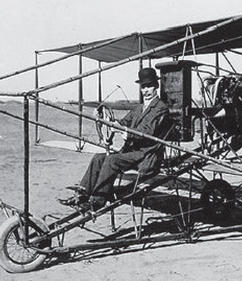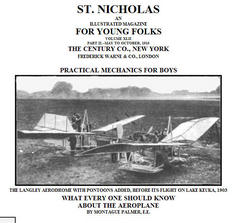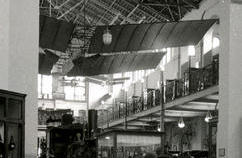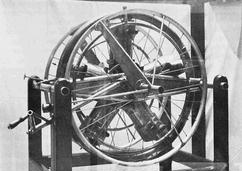|
 hroughout
these events, the Smithsonian stuck to its version of the Aerodrome
test flights. There was a need to do so. Fiscally conservative
members of Congress and the military were being dragged reluctantly
into the twentieth century where wars were decided by weapons as
much as tactics. A good national defense strategy had to include a
heavy investment in technology. The performance of the Langley
Aerodrome had become central to a much larger conversation that the
country was having about the role of the government in the advance
of science and technology. It was counterproductive for someone to
point at “Langley’s Folly” as an example of an investment that
didn’t pay off. More important, for the Smithsonian to admit that
they had misrepresented the facts of the Hammondsport trials would
be as much of an embarrassment as the 1903 failure of the Aerodrome. hroughout
these events, the Smithsonian stuck to its version of the Aerodrome
test flights. There was a need to do so. Fiscally conservative
members of Congress and the military were being dragged reluctantly
into the twentieth century where wars were decided by weapons as
much as tactics. A good national defense strategy had to include a
heavy investment in technology. The performance of the Langley
Aerodrome had become central to a much larger conversation that the
country was having about the role of the government in the advance
of science and technology. It was counterproductive for someone to
point at “Langley’s Folly” as an example of an investment that
didn’t pay off. More important, for the Smithsonian to admit that
they had misrepresented the facts of the Hammondsport trials would
be as much of an embarrassment as the 1903 failure of the Aerodrome.
In August of
1915, Albert Zahm published “The First Man-Carrying Aeroplane
Capable of Sustained Free Flight: Langley’s Success as a Pioneer in
Aviation” in the Annual Smithsonian Report for 1914. Zahm mentioned
the two separate goals of the project, and also claimed that the
first goal – the vindication of Langley – was accomplished May 28
through June 5 “…with the Langley aeroplane, kept as nearly as
possible in its original condition.” He mentioned some of the
changes, but the implication was that these were made during the
second phase of the project as Curtiss was investigating the tandem
configuration. In the last sentence, he claimed that Langley
"developed and built the first many-carrying aircraft capable of
sustained free flight."As fate would have it, Zahm's paper appeared in
the Annual Report right after a paper by Orville Wright entitled,
"The Stability of Airplanes." In it , Orville described the science
behind the new Wright "automatic stabilizer" – the first autopilot –
for which he was awarded the Collier Trophy for aeronautics on 3
February 1914. Orville and Wilbur had worked together on the
stabilizer since 1905. With Wilbur now deceased, this achievement
was the last fruit of one of the world's most dynamic and prolific
partnerships. For the Smithsonian to use this same publication to claim for itself the Wrights' most important and hard-won accomplishment must
have hurt the surviving brother to his core.
Similar reports
and papers appeared in the Annual Reports of 1915 through 1918.The
spin in these articles began appearing in popular magazines, books,
and encyclopedias. The 1917 edition of Jane’s All the World’s
Aircraft, in its “Historical Aircraft” section, listed the
Langley Aerodrome as capable of flight. In another example, the
May-October 1915 edition of St. Nicholas, a popular magazine
for children, an article “What Every One Should Know About
Aeroplanes” opened with a photo of the Langley Aerodrome at Lake
Keuka and explained “…the vindication of this great pioneer’s work
was accomplished… when Mr. Glenn Curtiss flew the selfsame machine,
repaired of course, over Lake Keuka eleven years later.”
In 1918, the
Smithsonian restored the Aerodrome A to its original 1903
configuration and hung it in the Arts and Industries Building. The
original label simply identified the airplane, but this was soon
replaced with one that read, “The first man-carrying aeroplane in
the history of the world capable of sustained free flight. Invented,
built, and tested over the Potomac River by Samuel Pierpont Langley
in 1903. Successfully flown at Hammondsport, N.Y., June 2, 1914.” Up
until now Orville had held his tongue, thinking that any public
comment from him might be misinterpreted. “A denial of these
statements by me might have been looked upon by the public as a
jealous attack upon the work of a man who was dead,” Orville later
explained. But it was one thing to overstate Langley’s success in
magazines and books, and quite another to exhibit the Aerodrome as
the first true airplane in a museum whose purpose was to preserve
the history of the nation.
Orville began to fight back in earnest.
In Their Own Words
|

Dr. Albert Zahm in a Curtiss Model D. After the 1914 trials of the
Langley Aerodrome, Zahm remained in Curtiss's employ for a short
time.

The opening page of "What Everybody Needs to Know About the
Aeroplane" from St. Nicholas
magazine in 1915.

The Langley "Aerodrome A," restored to its original 1903
configuration and hanging in the Smithsonian's Arts and Industries
Building.

The Manly-Balzer engine that had powered the Aerodrome eventually
became an exhibit in its own right.
|